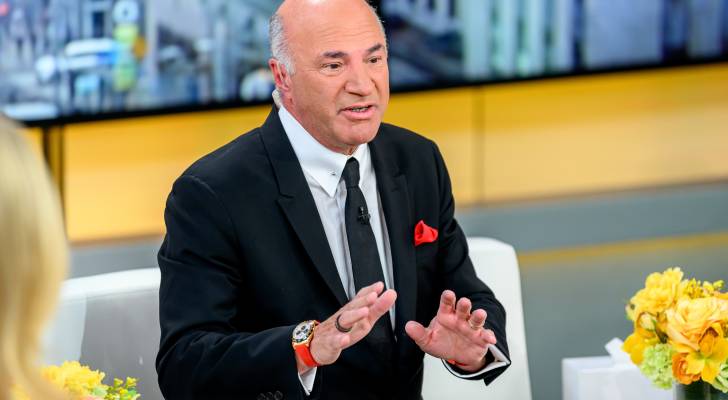Kevin O’Leary speaking
Dragon’s Den star investor Kevin O’Leary is known for his unfiltered takes on money and investing. And when it comes to a specific tangible asset — one he literally wears every day — he doesn’t hold back.
“Is investing in a luxury watch a good investment, or a stupid flex?” he asked in a recent YouTube video, flashing two high-end timepieces — one on each wrist.
While watches keep time, O’Leary explained, they also mark time — especially when purchased to commemorate life’s milestones. “Maybe you had a great deal, maybe you had a child, or you went to college, you graduated, whatever it is, you’re always going to remember that event from your watch,” he said.
Indeed, many people buy luxury watches to celebrate personal achievements — and O’Leary’s done that himself, many times. But he says there’s one golden rule to follow:
“The real rule is — never borrow money to buy a watch, ever. Just buy a watch you can afford.”
He even offered starter recommendations: “Start with entry-level products, great products like Grand Seiko or Tudor and then when something good happens, go nuts.”
To drive the “go nuts” point home, he brought both wrists closer to the camera. On one: a Rolex “Rainbow” Daytona, which can fetch more than $400,000 on the secondary market. On the other: a Patek Philippe Aquanaut Luce “Rainbow” — more rare and even more expensive.
To be sure, while some watches have appreciated in value over the years, that’s far from guaranteed. Not every model or brand sees gains — and even those that do rarely go up in a straight line.
According to the ChronoPulse Watch Index a global price indicator for the secondary watch market from luxury marketplace Chrono24 — luxury watch prices surged in 2020 and 2021, but began falling after peaking in March 2022.
For example, ChronoPulse’s Rolex Index has dropped 19% from its March 2022 peak. The Patek Philippe Index — which saw an even more dramatic surge in early 2022 — is now down more than 40% since its peak.
The good news? Watches aren’t the only alternative assets investors can explore. If you’re interested in tangible investments, here are more coveted assets favoured by the ultra-wealthy.
Story Continues
Read more: What is the best credit card in Canada? It might be the RBC® British Airways Visa Infinite, with a $1,176 first-year value. Compare it with over 140 more in 5 seconds
When it comes to preserving wealth, few assets have a track record as long and storied as gold. For centuries, the yellow metal has served as a safe haven during times of economic uncertainty, market volatility and inflation.
Unlike watches, gold doesn’t depend on fashion trends or collector demand to retain value. It’s globally recognized, highly liquid and — unlike paper currency — can’t be printed at will by central banks.
In fact, central banks around the world have been stockpiling gold. Ray Dalio, founder of the world’s largest hedge fund, Bridgewater Associates, recently highlighted gold’s importance in a resilient portfolio.
“People don’t have, typically, an adequate amount of gold in their portfolio,” he told CNBC earlier this year. “When bad times come, gold is a very effective diversifier.”
Over the past 12 months, gold prices have climbed by more than 35%.
One way to invest in gold that also provides significant tax advantages is to invest in gold stocks or ETFs.
Gold stocks help investors gain exposure to mining companies and gold-related assets without having to store physical gold. They’re held in a Tax-Free Savings Account (TFSA) or Registered Retirement Savings Plan (RRSP), for tax-efficient growth while protecting your funds from economic uncertainty.
Gold ETFs track gold prices or baskets of gold stocks, offering an easy, liquid way to invest. Similarly to gold stocks, they can also be held in TFSAs or RRSPs.
Few tangible assets work harder for investors than real estate — especially when it comes to generating passive income. While property values can fluctuate — just like stocks — real estate doesn’t rely on a booming market to generate returns.
Even in an economic downturn, high quality, essential properties keep generating passive income through rent. In other words, you don’t have to wait for prices to rise to see a payoff — the asset itself can work for you.
Legendary investor Warren Buffett has often pointed to real estate as a prime example of a productive, income-generating asset.
In 2022, Buffett stated that if you offered him “1% of all the apartment houses in the country” for $25 billion, he would “write you a check.”
Of course, you don’t need billions — or even to buy an entire property — to benefit from real estate investing. Crowdfunding platforms allow accredited investors to diversify their portfolio through residential, industrial or commercial properties while being free from landlord-related responsibilities.
The process is simple: browse a curated selection of properties that have been vetted for their appreciation and income potential. Once you find a property you like, select the number of shares you’d like to purchase and then sit back as you receive positive rental income distributions from your investment.
1. Chrono 24: Introducing the ChronoPulse – Watch Index Report: A look at the secondary market for luxury watches in Q1 2024 by Johannes Förster (April 30, 2024)
2. CNBC: Ray Dalio says the U.S. faces a ‘debt death spiral’(Feb 13, 2025)
This article provides information only and should not be construed as advice. It is provided without warranty of any kind.

